 |
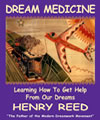
(WePublishBooks)

As
a doorway, dreams present to each of us our own individualized invitation.
For myself, one prospect that was inviting about dreams was their promise
of providing seeds of creative impetus. I think of Thomas Edison, asleep
in his laboratory. He gave the world a lightbulb.
What is
your lightbulb to give the world? It is said that each of us came into
the world with a purpose, with something to give. The Native Americans
honored this assumption with the tradition of the Vision Quest.
"Go seek your dream," they would say to the adolescent, "and
return to share with us who you are." The dream is a doorway to
learn how to realize our intended innovations, our unique experiment
in life, our gifts.
It has
been on such an optimistic note that I have endeavored over the years
to interest various people, community groups, businesses as well as
schools in the creative potential of dreams.
If creativity is an acceptable accent in which to engage people in dreams,
then art is certainly a readily expected domain in which to experience
that creativity.
Although the same principles would apply to using dreams for sources
of innovation in industry, for example, I have found it is easier to
introduce the general concept by demonstrating innovations in art that
have come from dreams.
One of
the ways, in fact, that I myself have learned to realize what my dreams
are showing me is through painting pictures. Besides prompting these
pictures, my dreams also gave me some help in the actual techniques
of painting with watercolors.
While I present some of these paintings to you here, I will share with
you some of my explorations learning to use dreams in art and in fostering
creativity.
Confidence
to be more yourself in your work–that seems to be the most general
result of working with dreams to enhance creativity–which allows
our naturally innovative nature to express itself. It was that way with
my own work.
I had begun
by drawing my dreams, using magic markers for color, doing so primarily
to commemorate them and to allow me to reflect upon them directly. I
didn’t feel I could "draw," as these dream drawings didn’t
look anything like my dreams.
But they "felt" right, and that seems to be what mattered
at the time. Then someone gave me a set of watercolors. I tried them
out, found them fun, but difficult to use.
I did what I could with them, rather enjoyed using a brush and a box
of colors, and was fascinated by what happened on the paper. Yet it
seemed difficult to express any intention through the watercolors. But
then I had a dream.
I
am in a movie theater looking at a large painting projected on the screen.
The painting is like a large stained glass window, the surface area
being divided into discrete areas, each filled with color. I hear my
father’s voice telling me that I can paint like that.
I used
this dream as a basis for simplifying my approach to learning watercolors.
By taking a piece of paper, drawing a design on it, then filling in
the spaces with color, I learned how to apply color to paper in a smooth
and even manner.
I learned how to mix colors and how adjacent colors affected each other.
I also learned how to build up color from several different coats of
paint. Although this approach to watercolor painting is somewhat trite,
it did enable me to learn some basic skills and gain confidence.
It was as if my dream was saying, "Look, I know you feel overwhelmed
by the complexity of watercolors, so why don’t you try it this
way for awhile?" One of my favorite paintings, "On the Way,"
emerged several years later, from this dream.
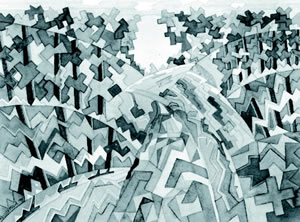
"On
The Way"
During
the time that I was practicing this approach, I was also attempting
to learn how to paint directly onto the paper. I was watching how my
practice in the disciplined approach would affect my more spontaneous
painting.
I would fill my brush with color and begin making marks on paper. I
would allow these marks to dry and then fill up with another color and
make more marks, on top of the previous ones at times.
I was concentrating on watching the various colors build up and interact
and had learned how to paint on top of paint without getting "mud."
I had another dream.
I
am painting under the supervision of Dr. Edith Wallace, my art therapist.
I am making marks on paper in a rather spontaneous manner. When I am
finished, she asks me to examine the painting to see what I would see.
I notice a figure implicit in the random marks, much the same way I
might see something in an ink blot, and experience a strong emotional
reaction to the discovery. My teacher says that when I encounter such
an emotional reaction, I’ll know I’ve found something.
This dream
encouraged me to pursue painting in the manner I had been exploring.
The importance of feeling was emphasized in the dream, as well as the
process of discovery.
The dream also marked another breakthrough for me. It suggested that
although I didn’t feel confident about setting out to paint "something,"
if I would simply put the brush to paper, make little marks, focus on
the sensory effects of the color, then something would probably emerge
from these marks that would give me a definite feeling of recognition.
I used this method of painting for several years, primarily as a psychological
tool. If I was in a mood and wanted to explore it, I would paint marks
on paper until I felt finished, examine the result until some figure
emerged that spoke to my mood.
I also found that this approach was a good one for painting in the mood
of a dream, and the resulting figures that I responded to would often
help me understand the import of the dream. These paintings were quite
personal–I called them my "psychological studies," and
were not suitable for showing to others.
Wanting to honor this dream, however, I painted "Dionysos"
using this method. As intricate and planned as it looks, I began by
some random marks and continued in this manner until a figure appeared,
which I then built up in increasing detail using the overlay method
I had developed.
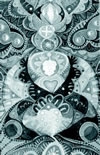
"Dionysos"
Dreams
can be the inspiration for art. They can provide the impetus to create,
the seed of what is to be created. For one thing, you can take a dream
and draw it.
Don’t worry whether you think you can make your drawing look like
how you remember seeing what was in your dream. Rather think of someone
you’d enjoy telling your dream to; only you can’t tell it,
you have to draw it.
A dream is a story and a picture tells it. Dreaming, itself, is a process
of drawing a picture, as in the slang expression for explaining the
obvious, "Do I have to draw you a picture?" or as in the phrase,
"drawing an analogy."
So drawing a dream is an extension of dreaming, it is in support of
dreaming. Drawing a dream is also one form of interpreting the dream.
It is the basic step in the art of dream realization.
The "Dream
Drawing Story Game" I’ll describe in a later chapter shows
how to make use of the interpretive dimension of a dream drawing.
Giving a person a drawing of your dream without telling them the dram
but having them make up a story about the picture will give you a subjective,
but definite, demonstration of just how much you have interpreted your
dream in your drawing.
My painting, "The Meeting," makes a good story about the potential
impact of this process.

"The
Meeting"
The dream
concerned my entering a restaurant and seeing a man sitting alone at
a table. When given the drawing, someone told a story of an artist at
work in his studio.
Hearing the story, I was surprised to have the man labeled an artist–a
placement on my scale of desirability just the opposite of how I had
regarded the man in the dream.
How could he be seen as an artist? What was I missing? Was it possible
that by rejecting the scruffy and seemingly inept parts of myself I
was turning away the opportunity to explore and develop my creative
talents?
My friend’s story forced a reevaluation of my dream, of that man
and of my attitudes. For one thing, I decided to suspend my usual judgment
of my doodles, designs and cartoons as awkward and inept, and allowed
them to have more free rein in the expression of my feelings and intuitions.
I treated this process with more respect and also invested in some art
supplies. Without this dream, and its interpretation, I doubt if I ever
would have become so dedicated in practicing artwork.
Drawing
the story of a dream, turning a dream into a picture, is only one way
to incorporate dreams into the subject matter of artwork. Simply the
mood of a dream can instigate a painting. What two or three colors express
the feeling in the dream?
Would this color be big or small, pointy or rounded, concentrated or
diffuse? How do the other colors fit in? Here we have the beginning
of an abstract expression. Making an abstract expression is a good way
to get in touch with one’s moods and to discover the meaning of
them.
It doesn’t have to be with marks on paper, however, as nonsense
noises, for example, that express the mood can evolve into a song, or
movements can evolve into a dance.
The mood of a dream, or the feeling residual, can be the most lasting
effect of a dream. Such a feeling can be difficult to put into words,
and we are its captive until we can find some way to give expression
to it that allows us to realize its meaning.
We can use painting, singing, dance, even poetry, to get in touch with
the feeling and, if we come up with a finished product that communicates
a meaningful feeling to others, perhaps we have gone another step in
the direction of art.
To supply
the content for art, we don’t have to use all the dream. A single
dimension may suffice. It could be the mood. Sometimes a single image
or symbol from a dream can be elaborated in a meaningful and powerful
manner.
That’s what I’ve done in my painting, "Flowering."
It is one image from one of my gardening dreams. In my chapter on "Inspirational
Writing" I will demonstrate the use of poetry for dream symbol
elaboration by writing a Haiku poem about this flower, calling it a
"Mouse Flower," to express its shy, but magical, qualities.
There were no white dots in the dream, but in the painting, the white
"twinklies" are a magical contrast to the flower’s rather
awkward lines of opening. I am less shy about my Mouse Flower today,
years later and I show it here to you. Perhaps it represents a budding
creativity.
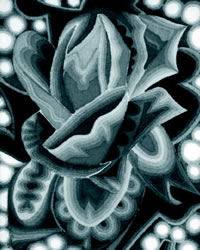
"Flowering"
Just as
you don’t have to use all of dream, so also do you not need to
restrict yourself to a single dream, but may draw from many all at once.
"Dream Shields," described in a later chapter, are a simple
way of combining dream symbols from many different dreams to create
a visual statement. As explained in that chapter, a dream shield can
be a mandala design using dream symbols as the content.
A mandala is usually a statement about the self, but one can combine
dream symbols–one’s own symbolic vocabulary–to create
statements about most anything.
Linking dreams together in this way, with an implicit story line or
theme, is the beginning of thinking mythically - explaining or answering
a question by telling a story composed of symbols from the unconscious.
Perhaps such an approach produces an allegorical painting. Think of
the juxtaposition of symbols in Magritte’s paintings, or the boxed
assemblages of Joseph Church.
I have
also been concerned with the spiritual essence of art, having to do
with the creative force, and helping people awaken to its presence in
their lives. A spokesman for this point of view might be Frederick Franck,
with his book, Art as a Way: A Return to the Spiritual Roots.
I also hearken back to the ancient Aztec tradition of the artist (toltecatl
= "wise man and artist") as an ideal, much as we might use
the phrase, "Christ Consciousness," to refer to an ideal,
a potential, a pattern of experience, a truth.
In the Aztec tradition, to be an artist was to know God as sHe manifested
uniquely in that artist’s heart and to take all pains necessary
to give truthful, and the most beautiful that the artist was capable
of, testimony of that presence.
I was able to test this approach by working with three artists over
an extended period to develop innovations and improvements in their
artwork through the study of their dreams.
The use
of dreams to develop innovations in the art technique excites me because
it generalizes to innovations in other areas of life. What do we know,
generally about dreams an innovations?
For the most part, from historical, anecdotal reports, they seem to
come unbidden to a person who has been wrestling hard with a problem,
and usually in very explicit form: in the dream, a solution or innovation
is witnessed.
I myself have had dreams that helped me innovate in my profession–the
experimental psychology of dreams–and in other areas, too, such
as the watercolor paintings shown here. Some dreams of innovations came
unbidden, others were incubated. Some were explicit portrayals of the
innovation, others required interpretation.
What I have found about trying to share with people the possibilities
for innovation through dreams is that the creative dreams of historical
record–those unbidden and explicit dreams–may inspire people,
yet paradoxically leave them passive, waiting until the day they might
be given such a dream.
It also gives them an unrealistic goal, in that there is the impression
that a creative dream is always distinguishable by its explicit portrayal
of an innovation. Not that I would deny that the most cherished and
valuable dreams may come unbidden and need no interpretation, but I
do believe that it is important to start with what you have and work
with it.
How I have
worked with selected artists to help them innovate with their dreams
is exactly how I have worked with anyone who was working on a problem
and who was willing to allow dreams to make a statement about their
work: What is your goal?
What are the perceived obstacles to your reaching your goal? What solutions
have you tried? In what ways have these solutions been satisfactory
and in what ways have they been unsatisfactory? What will be the consequences
of your achieving your goal? Are you afraid of any of the consequences?
Are there any rules of procedure that you feel you must abide by in
reaching your goal? What assumptions have you made about the nature
of your problem that limit your choice of solutions. The answers to
these sorts of questions help clarify the nature of the challenge the
person has accepted and the meaning it has for the person.
I assume that a work of art, like an invention, reflects the artist
or the inventor, that the process of interaction between the artist
and the raw materials reflects the artist as well as the materials,
but that the creator is primary.
When I take this perspective, then dreams become a natural helper, for
dreams are meant to clear a path among the objective realities in life
for the person’s subjective, but true, self to come out and contribute
to those objective realities.
Again, it’s that notion that everyone has a light bulb to contribute
to the world, and dreams are waiting for us to ask for their help in
finding and giving birth to that lightbulb. So let’s look at the
dreams.
When working
with someone on innovation and dreams, when we first look at the dreams,
they seem to have little to do with the work issue at hand.
To a large extent that is because most people separate their work issues
from their personal issues, so all the feelings, worries, conflicts
and other such typical dream contents, although they clearly relate,
when interpreted, to the dreamer’s person life, don’t seem
to relate to their work issues, which seem to be issues of competence,
pride, ignorance and acclaim.
But when their personal issues are seen in a broader perspective, and
when the answers to all the questions concerning the work goal are considered,
it becomes clear that the personal issues and the work problems are
both a part of the same core issues–discovering and risking being
more of yourself.
I remember
working with one artist, a ceramic designer, who was unsatisfied with
the textures she was able to obtain on the bowls she was making. We
spent a lot of time talking about what bowls meant to her; she had her
private reasons, which she didn’t feel were particularly relevant,
as well as her public, professional rationale.
One of her dreams involved a "shrimp boat." Discussion of
that dream revealed a worry that she would "miss the boat,"
a concern she had about her life in general as well as about her art,
a fear that she didn’t have what it takes, or had the "wrong
stuff," and would get left behind.
I had the impression that she had the "right stuff," but was
sitting on it because it didn’t match what she thought was expected,
what would gain recognition from her "art audience." She was
approaching her work left-handed, as it were, since she kept her better
hand behind her back.
When we got to talking about shrimp, I noticed that although she said
she didn’t like them, she was able to describe their texture in
some detail. It seemed as if she had some energy invested in the shrimp
texture, so I suggested that she explore this texture in her ceramics.
Out of this exploration came a new textural vocabulary which she developed
in her work. As part of this artistic breakthrough came also more self-acceptance
and confidence concerning the value of her own inclinations. The professional
and personal dimensions grew simultaneously.
Several
artists have participated in my work with dream incubation. I’ve
included two examples of their dream inspired drawings here. Eleizer
Canul, a Mayan artist, did the drawing shown here after we discussed
the use of dreams for making art.
In this dream, I am riding my bicycle (he didn’t know I was a cycling
enthusiast) right into the mouth of a Mayan sculpture. Much of his art
is the reproduction of ancient Mayan carvings, so it was a real pleasure
to see how a dream could inspire him to create something totally new.
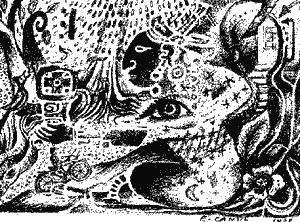
"Dream
of Henry" by Eleizer Canul
The second
drawing is by James Yax. Also a professional artist, his drawing of
meditation came from the dream he had while sleeping in the "dream
tent," going through the dream incubation process I described in
an earlier chapter.

"Dream
Tent Dream" Jim Yax
When I
was asked to be the subject of a Dream Art Exhibit, I was concerned
that somehow exhibiting my work would jinx my continued enjoyment of
painting. Perhaps I was simply nervous and self-conscious, not thinking
of myself as an artist-for-show but instead more an artist in spirit.
For most of the three months I spent preparing for the exhibit, I had
no dreams. I would have been a very frustrating subject for one of my
experiments.
But as I was getting more and more of my old paintings framed, and having
a chance to reflect upon how important it has been to me to have the
opportunity to paint, my focus shifted to my message to others: "Just
as I had lacked confidence in my ability and had been inspired by my
dreams, so can you be inspired by your dreams."
Then, a week before the show, I dreamed that the exhibit was opening,
and that I was outside, painting an invitation to the show on the sidewalk.
I awoke from this dream and immediately painted a sketch of how I was
painting on the sidewalk.
Then I was able to complete a finished painting in that style for the
exhibit (not shown here). I was grateful that my dreams had provided
me with something new to work on. Then, on the morning of the opening,
I awoke with another painting on my mind.
I painted that in my dream journal and realized that for me the process
of dreaming and painting would continue as an ongoing exploration. This
last dream removed my doubts and made it possible for me to be present
at the opening of my exhibit, answer questions, and share my delight
at the work.
I want
to tell you about another dream, because it shows just how dreams can
guide you toward some profound discoveries as you work with them. In
this dream, a secret is revealed to me:
I
am in a sacred cave. A voice of a Native American points out the dry
creek bed running through the cave, asking me to look at the designs.
I see how the water, rippling over the sand of the river bed, has carried
and distributed different colored minerals, creating beautiful patterns.
I realize I have seen this kind of thing before when the voice remarks
that such natural phenomena are where the Native Americans found the
designs they use in their art. I am amazed at this revelation.
I realized
that this dream, while it may have been pointing to a factual basis
of Native American art, was also providing me with a new way to look
at watercolor painting.
In such a method, one drags dissolved colored pigments over a textured
bed of paper, creating designs. I can see painting itself as an human
extension of an act of nature. This dream of the "Sundance Cave"
discovery kindles in me a new appreciation of the art making process.
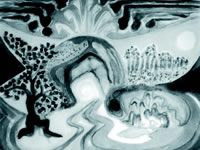
"Dream
of the Sundance Cave"
It is difficult
for me to form an evaluation of these paintings in terms of artistic
standards. From a psychological standpoint, I believe I see something
of merit in them. I see something of myself in these paintings, something
I like.
Some of my friends who are professional artists say that they value
the unique quality with which the watercolors are imbued, something
they say reminds them of what is special about me to them. It sounds
trite in words, and maybe all that is being reflected is love, or perhaps
spirit.
At another level, I can see how the paintings reflect something of my
psychology. These paintings are not the flowing, expressionistic happenings
that are often associated with watercolors at their finest. On the other
hand, although there is a precision to some paintings, they did emerge
somewhat spontaneously, like a doodle, and are full of expression.
I see the paintings reflect an integration of a long-standing polarity
within me, between planning and being spontaneous, evidencing an ability
to arrive at a dimly perceived goal through a long process of successive
approximations, which is a combination of both intentionality and chance.
Such integrations I value, and have my dreams to thank for them in many
areas of my life. The kind of improvisational activities involved with
dream interpretation generalizes, I believe, to encourage me to be spontaneous
elsewhere.
When I
was in college, for example, before I was into dreams and was an active
alcoholic, whenever I wanted to do some painting, I had to get drunk.
Otherwise I was too constricted to allow any kind of spontaneity.
After I "channeled" Jim Beam or Jack Daniels, the paint would
flow across the canvas. Sober, I could only do structured drawings,
drunk I could sling paint. After the recovery from active alcoholism
and several years of work with dreams, I found that I could now paint
quite spontaneously. It was a wonderful discovery.
Over time,
the relationship between what I was learning from my dreams and what
I was learning from painting combined to form my mandala painting meditation
practice. From dreams I was learning to integrate the opposites within
and without.
Mandalas, designs made from circles and squares, are symbolic of the
integration of the opposites. I found that painting mandalas provided
me with a safe place to practice the spiritual meaning of integration
I was learning from my dreams.
Allowing the archetypal structure of the mandala to guide me in the
background, I gradually developed confidence in the watercolors as I
painted the mandalas rapidly, spontaneously, with little conscious deliberation.
My greater intimacy with the feeling of moving the pigments across the
paper allowed an increasing freedom of movement in my painting.
I began to see in my paintings what I learned from my dreams: On one
level, it seems that I am the author of my life, but on another level,
I can detect the presence of another intelligence at work who is guiding
the action.
When I cannot remember my dreams, I can paint, and find the needed mirror.
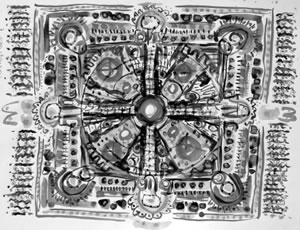
"Celebration
Mandala"
Getting
help from my dreams has seemed to involve my being open to innovative
modes of perception as well as feeling of greater self-acceptance.
Dreams knit together the contradictory and conflicting aspects of my
personality in ways that I could never have invented myself.
As when my first dream slowly taught me the value of the rejected potato
chips and mayonnaise, so later dreams have given me the confidence to
let go of any limited notion of how I "should" be and discover
instead how I actually am created–in the image of the Maker.
Each of us is creative, each in a unique way. Dreams seem to want to
help us discover that there is a whole lot more to us than we ever suspected.
Although
they need to be approached and treated with the respect due a sovereignty,
dreams are not really an end in themselves. Their secret is that they
are but a doorway to a more valid and meaningful perception of life
than we normally obtain through our extraverted, materialistic education.
Dreams provide us with an innate, alternative education, and do so simply
by working on our consciousness with stories that affect us at a deep
emotional level. The greatest truths lie within us and come to the surface
in our dreams. We needn’t agonize over these dreams, trying to
break their code.
There is no code. They are simply stories we need to remember and to
bring into our lives in a variety of natural ways. In that way they
can guide us, not only in our own search for happiness, but also in
our efforts to prepare a better world in these difficult and threatening
times.
I can think of no other renewable resource that is as universally available
for developing that vital link to nature’s own invisible laws and
purposes and to the spirit’s activity within us than getting help
from our dreams.
Each of us has a special, unique light to share. Research into our dreams
can help us each bring enlightenment to others in the way only each
of us can, and discover who we really are in the process.
*This
excerpt copyright ©2005 Henry Reed
To order
this book from WePublishBooks, click
here!
To see
more of Henry Reed's art, go to:
www.henryreed.com/artgallery
To see
a collection of Henry Reed's mandalas, go to:
www.dailymandala.blogspot.com
|
|


